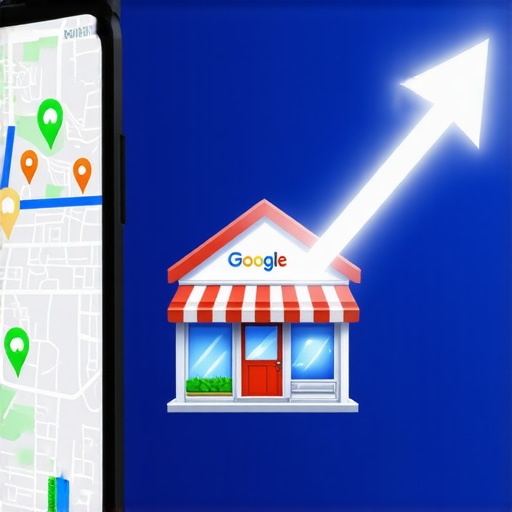My Journey to Better Google Maps Rankings: A Personal Tale
As a local business owner, I vividly remember the frustration of seeing my competitors rank higher on Google Maps despite offering similar services. I knew that improving my Google Maps visibility was crucial, but I didn’t know where to start. That was until I discovered the power of GMB booster services, which transformed my local SEO game. Today, I want to share my insights and practical tips on how you can quickly boost your Google Maps rankings using proven strategies.
Why I Chose a GMB Booster Service for Fast Results
Initially, I tried manual optimization—claiming my listing, adding photos, and encouraging reviews. While these helped, progress was slow. I needed faster results, especially with the increasing competition in my area. After researching, I found that GMB booster services offered a comprehensive solution to accelerate rankings. They leverage proven techniques like citation building, optimized profiles, and targeted local SEO, which I found to be effective based on real-world examples.
How to Speed Up Your Google Maps Rankings: My Personal Tips
One thing I learned from my experience is that consistency is key. Regularly updating your GMB profile, engaging with reviews, and maintaining accurate NAP (Name, Address, Phone Number) information are fundamental. Additionally, utilizing strategic keywords naturally within your profile content helps Google understand your business better. For example, I integrated keywords like “trusted local plumber” and “emergency plumbing services” organically, which improved my visibility.
What Are the Best Tactics to Outrank Competitors Quickly?
In my journey, I found that combining a solid GMB profile with local SEO techniques, such as backlinks and citation consistency, accelerated my rankings. I also used targeted promotions and Google Maps marketing tactics to boost my presence. For a more detailed blueprint, I recommend exploring the ultimate Google Maps SEO guide. Remember, patience and persistence are essential, but these strategies significantly shorten the path to the top.
If you’re serious about dominating your local area, consider consulting with specialists who offer proven Google My Business optimization services. They can tailor strategies specifically for your niche and location.
If you’ve tried similar tactics or have your own success stories, I’d love to hear about them! Sharing experiences can help us all grow.
To learn more about managing and optimizing your GMB profile, visit this comprehensive guide.
Unlocking Advanced Techniques for Local SEO Domination
As seasoned professionals in local SEO, we recognize that staying ahead in Google Maps rankings requires a nuanced approach beyond basic optimizations. Incorporating cutting-edge tactics such as leveraging Google My Business (GMB) API integrations, utilizing schema markup, and consistently monitoring your competitors can provide a significant edge. These strategies help refine your profile’s relevance and authority, making your listing more attractive to Google’s algorithm.
Why Advanced Optimization Methods Matter More Than Ever
In today’s competitive landscape, simple profile updates aren’t enough. According to GMB SEO experts, integrating real-time data feeds, maintaining a dynamic content strategy, and engaging with user-generated content are proven methods to elevate your ranking. These tactics contribute to a more authoritative and trustworthy profile, which Google favors when determining local relevance.
How Can You Sustain Long-Term Google Maps Success?
Consistency in review management, proactive engagement, and local link building are crucial for sustained growth. Implementing a review acquisition system that encourages genuine feedback, combined with strategic citation management, can solidify your local presence. Regularly updating your Google Business Profile with seasonal promotions, new services, or community involvement signals activity, which Google interprets as relevance.
What Are the Potential Pitfalls in Local SEO That Experienced Business Owners Should Avoid?
Over-optimization is a common mistake; keyword stuffing or fake reviews can lead to penalties and loss of trust. Moreover, neglecting mobile optimization of your GMB profile and website can severely limit your visibility. It’s essential to follow the latest best practices outlined by trusted sources like industry-leading experts who emphasize the importance of authentic engagement and technical accuracy.
For tailored strategies that align with your specific industry and location, consider exploring comprehensive service packages like those detailed in top SEO packages. These packages often include audit, optimization, and ongoing management, which are vital for staying competitive in 2025 and beyond.
If you’re eager to deepen your knowledge, I recommend reading more about effective local SEO tactics and how they can be integrated into your overall marketing plan. Sharing your experiences or asking questions in the comments can help create a community of growth-oriented local businesses.
Need assistance? Reach out to our team through this contact form for expert guidance tailored to your business needs.
Beyond the Basics: Embracing Complexity for Lasting Success
When I first started optimizing my Google My Business (GMB) profile, I believed that simple updates and consistent reviews would suffice. However, diving deeper into advanced strategies revealed that local SEO is a complex ecosystem, requiring a nuanced approach. Incorporating schema markup, leveraging GMB API integrations, and monitoring competitors became essential tools in my arsenal. These techniques, as highlighted in expert guides like the ultimate Google Maps SEO guide, significantly enhanced my profile’s authority and relevance, helping me climb the rankings faster and more sustainably.
Reflecting on the Journey: The Real Challenges and Rewards
Looking back, I realize that the true challenge was maintaining consistency and authenticity. It’s tempting to fall into the trap of keyword stuffing or fake reviews, but such shortcuts can backfire, leading to penalties or loss of trust. Instead, I focused on genuine engagement—responding thoughtfully to reviews, updating my profile with community involvement, and sharing valuable content. This authentic approach not only improved my rankings but also fostered stronger relationships with my customers. Sharing these experiences, I encourage fellow entrepreneurs to view local SEO as a long-term relationship, not just a quick fix.
What’s Next? Navigating the Future of Local SEO with Confidence
As technology evolves, so does the landscape of local SEO. Emerging tools like AI-driven local search analysis and voice search optimization are shaping the future. To stay ahead, I continuously educate myself through resources like top SEO packages for 2025 and industry updates. My advice? Embrace change, experiment with new tactics, and never stop learning. Remember, your journey to the top isn’t a sprint but a marathon—each step, each adjustment, bringing you closer to local dominance.
If my story resonates with you, I’d love to hear about your experiences. Sharing insights and challenges can create a supportive community of local businesses striving for excellence. Feel free to comment below or reach out through this contact form. Let’s grow together!
Why Deep Technical Optimization Is Crucial for Sustained Local Dominance
While basic GMB profile updates can yield quick wins, true long-term success hinges on embracing advanced technical strategies. Implementing schema markup tailored for local businesses, such as LocalBusiness schema, helps search engines better understand your offerings and location, boosting your relevance in local searches. Moreover, leveraging GMB API integrations allows for real-time updates and insights, streamlining your management process and ensuring your profile remains dynamic and competitive.
In my experience, integrating these sophisticated techniques has consistently driven more qualified traffic and higher conversion rates. As highlighted by industry-leading experts, the key is to align technical enhancements with user intent and local relevance. This approach not only improves rankings but also enhances the overall user experience, leading to stronger customer engagement and loyalty.
How to Harness Competitor Analysis for Strategic Edge
Understanding your competitors’ strategies can unlock new growth avenues. Using tools that monitor their citation profiles, review acquisition tactics, and keyword targeting reveals gaps and opportunities within your niche. For example, I found that some competitors were underutilizing local backlinks, which I promptly addressed through targeted outreach and content marketing. This nuanced analysis, combined with continuous tracking, helps craft a resilient, adaptable SEO strategy grounded in data-driven insights.
Google’s algorithm increasingly favors authoritative, well-rounded profiles. As per local SEO specialists, maintaining an active competitive intelligence process is indispensable for staying ahead. It’s a continuous cycle of refinement—adapting your tactics as the local landscape evolves and new opportunities emerge.
What Are the Best Practices for Future-Proofing Your Local SEO Strategy?
Future-proofing requires a proactive stance toward upcoming trends like voice search, AI-driven local insights, and mobile-first indexing. Optimizing for voice search involves natural language keyword integration and frequently asked questions (FAQs) that mirror user queries. Additionally, investing in mobile optimization ensures your profile remains accessible and attractive to on-the-go consumers, which is critical given the increasing reliance on smartphones for local searches.
Staying ahead also means engaging with emerging platforms and content formats, such as Google Posts and Google Q&A. These features keep your profile lively and relevant, signaling activity to Google and users alike. For further insights, I recommend exploring comprehensive future-proofing guides that detail actionable tactics for the years ahead.
How Can You Leverage Data Analytics to Refine Your Local SEO Efforts?
Data analytics is the backbone of a resilient SEO strategy. By examining metrics like click-through rates, user engagement, and conversion patterns, you can identify what resonates most with your audience. Tools that integrate Google Analytics with your GMB insights provide a holistic view of customer behavior, enabling precise adjustments. For instance, I discovered that certain service descriptions prompted more inquiries, leading me to optimize my profile content accordingly.
Consistent monitoring and iterative improvements based on data ensure your efforts remain effective and adaptable. As suggested by SEO authorities, embracing a data-driven mindset transforms your local presence into a sustainable competitive advantage. If you’re keen to explore these advanced strategies in detail, don’t hesitate to reach out through our consultation services. Let’s craft a tailored roadmap to elevate your local rankings and secure your spot at the top.
Things I Wish I Knew Earlier (or You Might Find Surprising)
Hidden Power of Consistency
One thing that truly changed my game was realizing how vital consistent engagement is. Regularly updating my profile and responding to reviews created a momentum that Google couldn’t ignore, and it made a noticeable difference in my rankings. I wish I had started this habit sooner.
The Myth of Quick Fixes
I used to believe that quick, overnight strategies could catapult my local rankings. However, I found that sustainable growth comes from steady, long-term efforts like citation building and authentic review management. Patience really pays off.
Understanding The Role of Local Content
Adding local content, such as community involvement and local keywords, made my profile more relevant. It wasn’t just about keywords but about telling a genuine story that connected with my community, which resonated with Google and customers alike.
The Impact of Technical Optimization
Technical details like schema markup and API integrations might seem complex, but they dramatically improved my profile’s visibility. Investing time in these areas helped my listing stand out in the crowded local search results.
Competitor Analysis is a Game Changer
Studying what my competitors were doing—especially their backlinks and review strategies—gave me ideas to differentiate and improve my own profile. Keeping an eye on the competition helps me stay ahead and adapt quickly.

